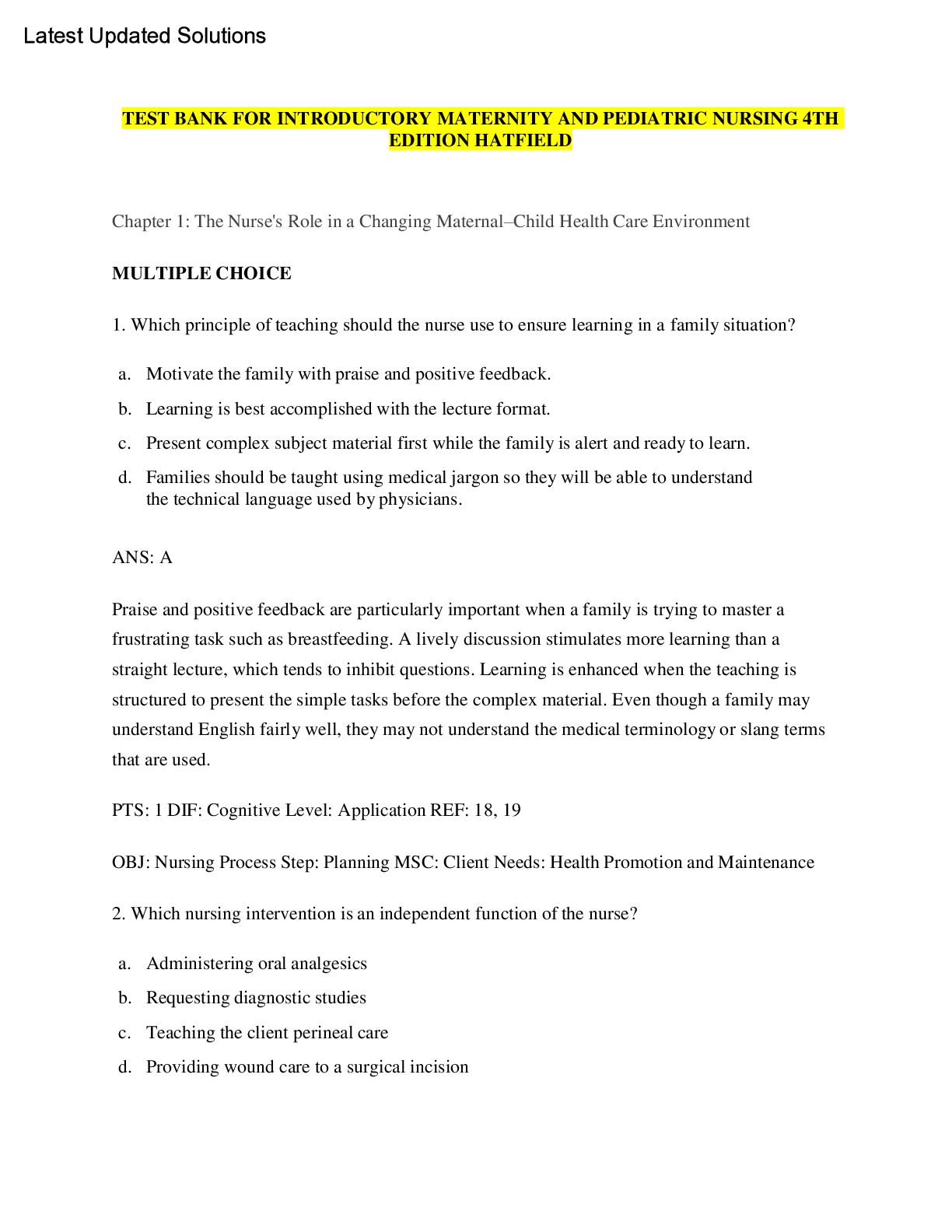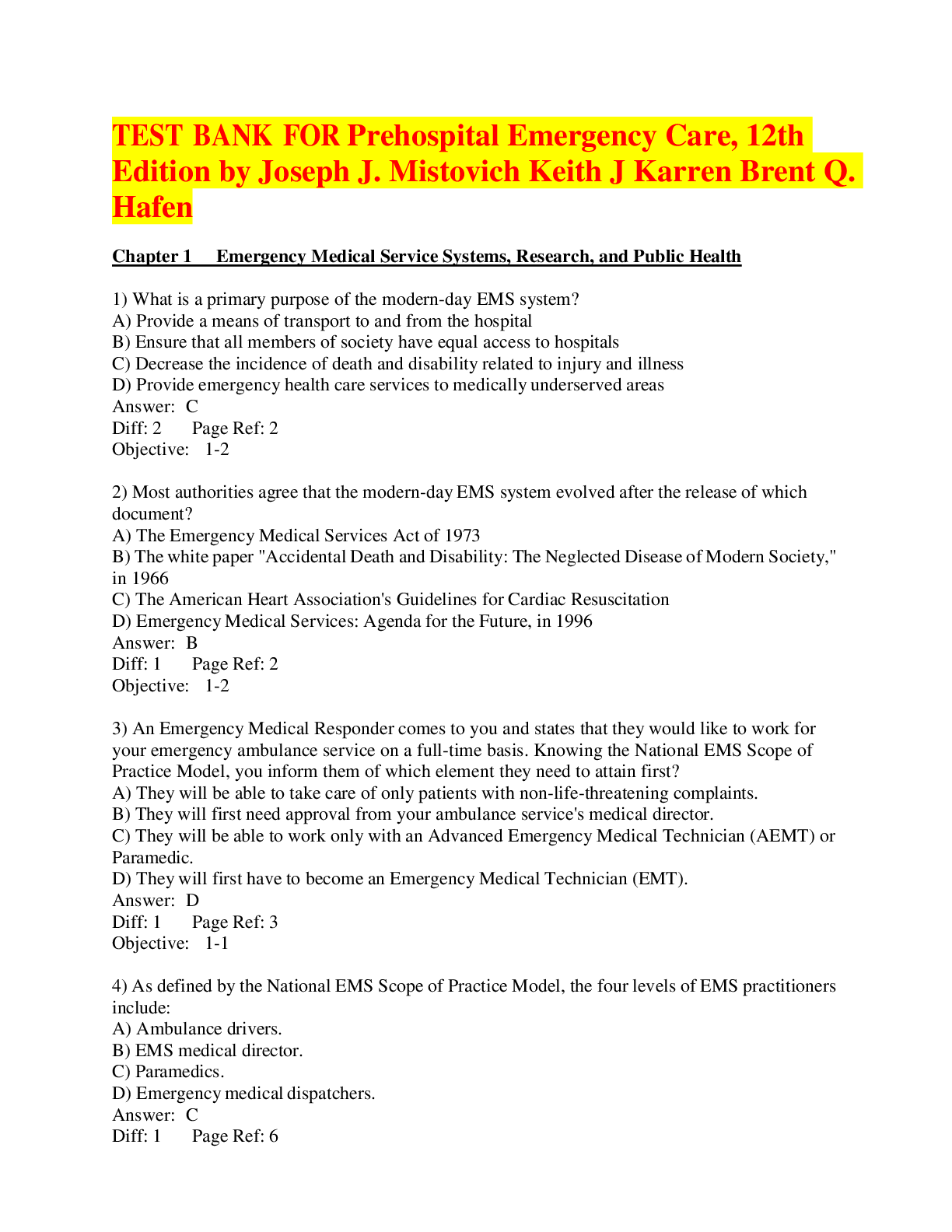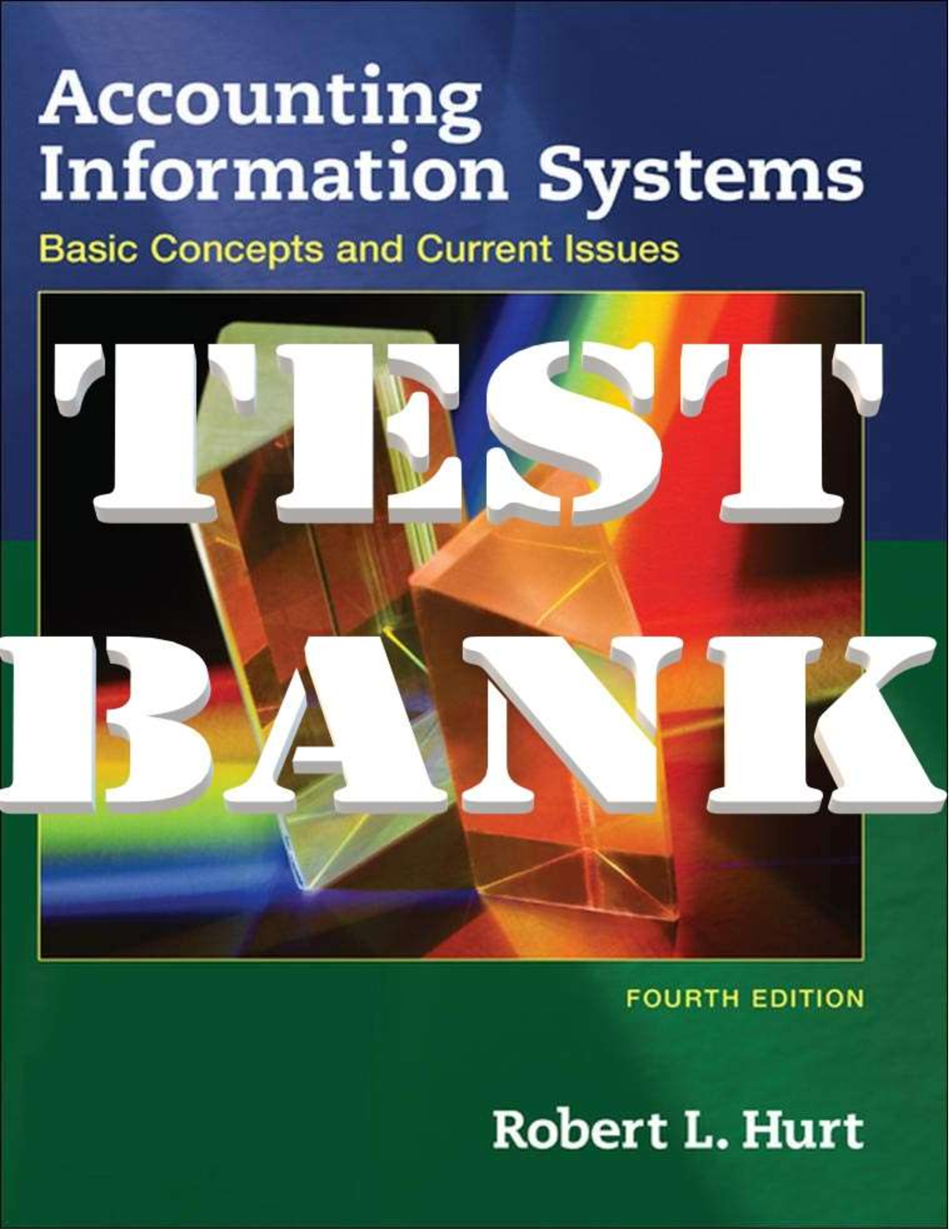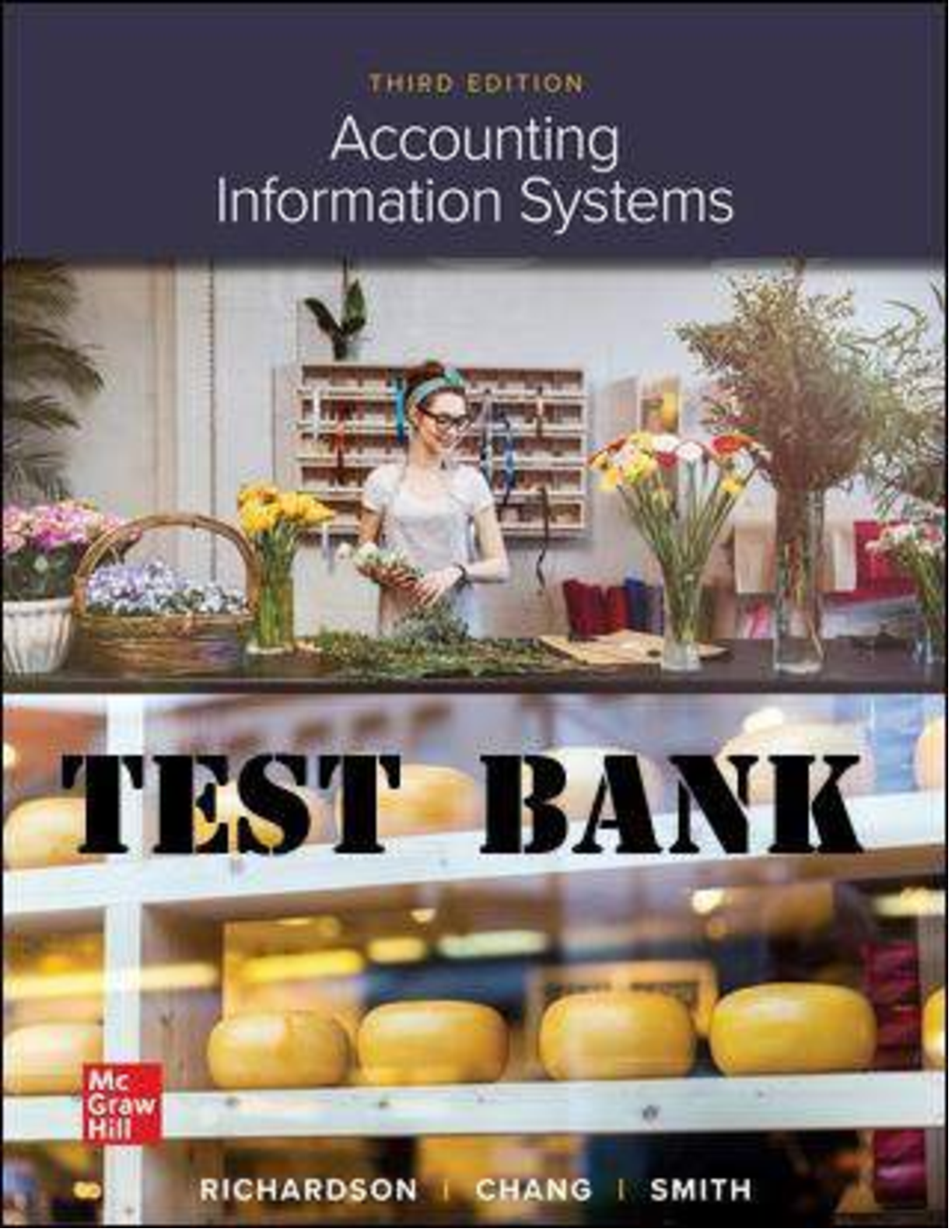Accounting > TEST BANKS > Testbank For Accounting Information Systems Understanding Business Processes 4e (All)
Testbank For Accounting Information Systems Understanding Business Processes 4e
Document Content and Description Below
Testbank For Accounting Information Systems Understanding Business Processes 4e-Chapter 1: Systems fundamentals Multiple Choice Questions 1. The role of the accountant has changed in recent times be... cause: a. professional bodies have sought to redefine and reposition the accounting function. *b. computer systems have emerged to handle the classification and recording tasks traditionally associated with the accounting function. c. the accounting cycle is too complex and involved to be performed solely by the accountant. d. knowledge workers have increasingly replaced accountants in the performance of recording and classification tasks. Correct answer: b Learning Objective 1.1 ~ Define and describe accounting and explain how information systems have altered the role of accounting and the job of the accountant 2. As computer systems have been developed to perform the recording and classification tasks associated with business activities, the nature of accounting and the work of the accountant have also been pushed in a new direction. Increasingly, the role of the accountant is seen to be to: a. use computer programs rather than manual journals. b. ensure that businesses invest in new software. *c. add value and provide and interpret information for an organisation. d. outsource accounting work to bookkeepers. Correct answer: c Learning Objective 1.1 ~ Define and describe accounting and explain how information systems have altered the role of accounting and the job of the accountant 3. The ICAA requires that its members should bring their analytic expertise to several fields. Which one of the following field is NOT specified by the ICAA? a. Strategic planning and change management. b. Market analysis and compliance. c. The use of information technology. *d. Human resource management. Correct answer: d Learning Objective 1.1 ~ Define and describe accounting and explain how information systems have altered the role of accounting and the job of the accountant Testbank to accompany: Accounting information systems 4e 4. What does ERP stand for? *a. Enterprise Resource Planning b. Enterprise Resource Package c. Electronic Resource Planning d. Electronic Resource Package Correct answer: a Learning Objective 1.1 ~ Define and describe accounting and explain how information systems have altered the role of accounting and the job of the accountant 5. Which of the following statements is NOT a major reason of why accountants of the twenty-first century must be comfortable with information systems concepts? a. Computer systems are playing an increasing part in the management and functioning of the organisation. b. Accountants are increasingly exposed to and working with technology and information systems. c. Accountants need to know how computers manage knowledge and its data resources. *d. Accountants need to lead and oversee the design of an accounting information system. Correct answer: d Learning Objective 1.1 ~ Define and describe accounting and explain how information systems have altered the role of accounting and the job of the accountant 6. Information is: a. the same as data. *b. data that has been processed and converted. c. less useful than data. d. raw facts describing an event. Correct answer: b Learning Objective 1.2 ~ Define and describe information Chapter 1: Systems fundamentals 7. What is information overload? a. The situation where a computer has more information than is needed or is able to be processed in a meaningful way when a computer program is executed. *b. The situation where an individual has more information than is needed or is able to be processed in a meaningful way when working through a decision. c. The situation where a computer has more information than is needed or is able to be processed when data storage is taking place. d. The situation where the amount of information exceeds the storage capacity of the brain of a human being. Correct answer: b Learning Objective 1.2 ~ Define and describe information 8. Which of the following statements best indicates the difference between data and information: a. information and data are the same. b. information is less useful than data. c. information is always useful whereas data is only sometimes useful. *d. information is data that has been processed and converted Correct answer: d Learning Objective 1.2 ~ Define and describe information 9. The following message box appears when entering a customer order into a sales system: This is an example of: a. Input b. Process c. Output *d. Feedback Correct answer: d Learning Objective 1.3 ~ Define and describe a system, using examples Testbank to accompany: Accounting information systems 4e 10. A system can be defined as: a. activities that are performed on inputs. b. any device used to capture data including manual keying and scanning. c. any process that an accountant is involved in. *d. something that takes inputs, applies a set of rules or processes to the inputs and generates outputs. Correct answer: d Learning Objective 1.3 ~ Define and describe a system, using examples 11. Inputs can include: a. receipts and invoices that are given to customers. *b. data as well as other resources, that are the starting point for the system. c. any process that an accountant is involved in. d. computer reports that are analysed by accountants. Correct answer: b Learning Objective 1.3 ~ Define and describe a system, using examples 12. A large company that provides supplies to the defence forces has just established a new accounting system. Which of the following is an example of a factor in the external environment that would impact on the design of this system: a. the specification details gained from users. b. the directive from the finance director about the system’s operation capacity. c. the defence force requirement regarding e-commerce. *d. the accounting standards governing large companies. Correct answer: d Learning Objective 1.3 ~ Define and describe a system, using examples 13. MICR is an input technology used: a. on receipts and invoices that are given to customers. *b. on bank cheques. c. in the processing of ATM receipts. d. by many organisations to expedite the processing of accounts payable invoices. Correct answer: b Learning Objective 1.3 ~ Define and describe a system, using examples [Show More]
Last updated: 5 months ago
Preview 5 out of 302 pages

Loading document previews ...
Buy this document to get the full access instantly
Instant Download Access after purchase
Buy NowInstant download
We Accept:

Reviews( 0 )
$16.50
Can't find what you want? Try our AI powered Search
Document information
Connected school, study & course
About the document
Uploaded On
Jan 06, 2025
Number of pages
302
Written in
Additional information
This document has been written for:
Uploaded
Jan 06, 2025
Downloads
0
Views
18





_compressed.png)
.png)
.png)


.png)



.png)

 Accounting information systems 11th edition bodnarHopwood.png)



_watermark.png)

.png)

